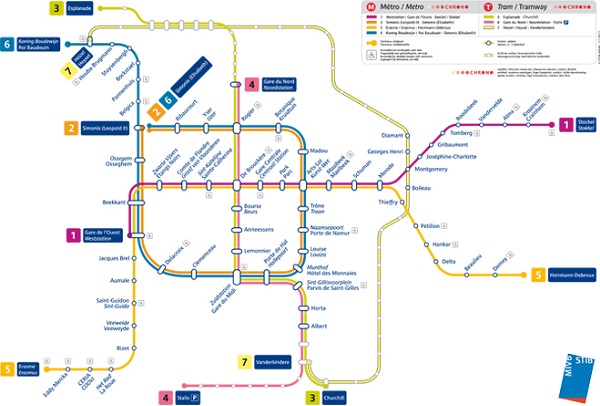That a world-mapping should include our assumptions
[ by Charles Cameron — Lorenz’ butterfly : tornado :: Fukushima’s rat : earthquake? + Brussles metro attack ]
.
Brussels metro & tramway map
**
For every unintended consequence, there’s an assumption that was assumed and thus overlooked, forgotten, unfairly assigned to oblivion, amirite? Sometimes we’re fortunate, and a pattern emerges that can then be written into checklists, and repeat unintended consequences subsequently averted, if we heed the checklists, ahem.
Consider this stunning paragraph, from a Union of concerned Scientists‘ 2013 piece titled Fission Stories #133: Mayflies, and Squirrels, and Rats, …:
Fukushima Daiichi recently received worldwide media attention when another power outage once again interrupted cooling of the water in the Unit4 spent fuel pool for several hours. The culprits in 2011 were an earthquake that knocked out the normal supply of electricity to the cooling system and a tsunami that disabled the backup power source. This time, a rat was the culprit. It chewed through the insulation on an electrical cable, exposing wires that shorted out and stopped the cooling system. It was also the rat’s final meal as the event also electrocuted the guilty party.
Part of what’s so conceptually audacious here is the implicit risk equation, okay, perhaps I should call it the implicit risk approximation:
**
Take the Brussels metro attack: in my less-than-graphically-ideal mapping below, the left hand column shows what was intanded by the police to be the order of events as they initiated them in response to the airport attack a little earlier:
while the two centered annotations in red indicate the unverified assumption that interfered with the sequence of events as intended by the police, and the right hand column shows what actually transpired.
Exceopt that the situation was wildly more complex than that — a point not germane to my argument here, but elaborated upon in today’s WaPo article, The email that was supposed to prevent the Brussels metro attack was sent to the wrong address. Which see.
**
Getting back to Fukushima, the earthquake and the rat, perhaps we can now take the title of Edward Lorenz‘ remarable paper that gave us the term “butterfly effect” — Predictability: Does the Flap of a Butterfly’s Wings in Brazil Set Off a Tornado in Texas? — out of the realm of speculation, and into the realm of improbable yet actualized comparables, by rephrasing it thus: Predictability: Does the Bite of a Rat’s Teeth in Fukushima Have Comparable Effect to an Earthquake in Fukushima?
Oh, and just because something is predictable doesn’t mean it’s predicted — and just because something is predicted doesn’t mean the prediction will be heard or heeded.
And that’s an anticipable consequence of the way we are.
**
In the matter of Quixote:
I have this quixotic wish to see a map of global dependencies — it’s something I’ve thought about ever since Don Beck told me “Y2K is like a lightning bolt: when it strikes and lights up the sky, we will see the contours of our social systems” — and I’ve talked about it here before, in eg Mapping our interdependencies and vulnerabilities [with a glance at Y2K].
It’s a windmill, agreed — a glorious windmill! — and indeed, combining all our potential assumptions about even one single Belgian metro station in the course of just one particular morning and adding them to a map — or a checklist — would be another.
Tilting at windmills, however, is one of the great games of the imagination, frowned upon by all the righteously serious among us, well-suited to poets — and having the potential to help us avoid those damned unintended consequences.





